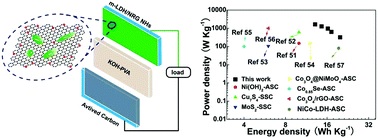韩敏教授课题组和戴志晖教授课题组合作在NANOSCALE发表研究论文
Integrating ultrathin and modified NiCoAl-layered double-hydroxide nanosheets with N-doped reduced graphene oxide for high-performance all-solid-state supercapacitors
Liu, F (Liu, Fei)[ 1 ] ; Chen, YY (Chen, Yuyun)[ 2 ] ; Liu, Y (Liu, Ying)[ 1 ] ; Bao, JC (Bao, Jianchun)[ 1 ] ; Han, M (Han, Min)[ 1 ]*(韩敏); Dai, ZH (Dai, Zhihui)[ 1 ]*(戴志晖)
[ 1 ] Nanjing Normal Univ, Sch Chem & Mat Sci, Jiangsu Key Lab Biofunct Mat, Nanjing 210023, Jiangsu, Peoples R China
[ 2 ] Guangxi Univ Nationalities, Sch Chem & Chem Engn, Nanning 530008, Peoples R China
NANOSCALE,201905,11(20),9896-9905
As one class of important electroactive materials, layered double-hydroxide (LDH) nanostructures show great promise for application in the fields of electrocatalysis, secondary batteries, and supercapacitors. Nonetheless, the synthesis of ultrathin multi-metallic-based LDH nanosheets or related nanohybrids (NHs) remains a challenge, and their supercapacitive performances need to be further improved for achieving both high energy and high power densities. Herein, ultrathin and modified NiCoAl-LDH (m-LDH) nanosheets and N-doped reduced graphene oxide (NRG) NHs were synthesized by an alkaline etching of pre-synthesized ultrathin NiCoAl-LDH nanosheets, followed by electrostatic assembly with NRG. The alkaline etching could efficiently modulate the chemical states of the active Ni/Co elements and create more oxygen vacancies in the m-LDH nanosheets. After integrating m-LDH with NRG, the strong interaction or efficient electronic coupling of those two constituents further mediated the surface electronic structure of the m-LDH nanosheets, improving the interfacial charge transport and offering more available electrochemical active sites for surface faradaic reactions. Thus, the obtained m-LDH/NRG NHs manifested greatly enhanced specific capacitance (1877.0 F g(-1) at 1 A g(-1)), which was superior to that of pure m-LDH and most other reported electrode materials. Moreover, using such NHs as the positive electrode and activated carbon as the negative electrode, a fabricated asymmetric all-solid-state supercapacitor device delivered a high energy density of 19.9 W h kg(-1) at a power density of 319.8 W kg(-1) together with good cycling stability (76.5% capacitance retention after over 5000 cycles). Remarkably, even at a power density up to 1637.5 W kg(-1), it could still retain an energy density of 13.1 W h kg(-1), superior to recently reported asymmetric supercapacitors devices based on Ni, Co, and other transition metal compounds.

文章链接:
https://pubs.rsc.org/en/content/articlelanding/2019/NR/C9NR02357G#!divAbstract
版权与免责声明:本网页的内容由收集互联网上公开发布的信息整理获得。目的在于传递信息及分享,并不意味着赞同其观点或证实其真实性,也不构成其他建议。仅提供交流平台,不为其版权负责。如涉及侵权,请联系我们及时修改或删除。邮箱:sales@allpeptide.com